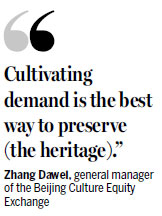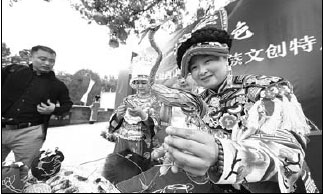Cultural heritage holds great market potential
For Yang Huazhen, a master of Tibetan embroidery, a national intangible cultural heritage craft, the focus of her work is to research, collect and pass her traditional skills to the next generation, she told China Culture Daily.
"I know little about business," the 60-year-old said. "Given my age, I don't want to waste my time learning it."
Some international brands have contacted Yang for authorization to use her creations in their product packaging designs in recent years, which inspired her to develop her own brand, she said.

Yang's experience reflects one of the hot issues related to cultural heritage - its sustainable protection and rational utilization, which involves injecting capital into the sector.
China has a rich, diverse cultural heritage reservoir, "yet from the perspective of investors, it is still a small market that has yet to be tapped", He Shixiang, general manager of Fortune Capital, said at a recent forum in Beijing.
British tea brand Lipton is a household name worldwide. In contrast, China, as the origin of tea and its culture, lacks influential global brands in the sector, He said.
The venture capital firm has more than 10 staff members focusing on investment in cultural businesses, yet none of the employees has looked into intangible cultural heritage, He said.
Despite currently receiving less attention from investors, He said he believes that rational use of traditional culture has potential.
Echoing He's opinion, Zhang Dawei, general manager of the Beijing Culture Equity Exchange, said he also has faith in the sector's future.
When it comes to intangible cultural heritage, people tend to stress its artistic and cultural aspects, and are rarely aware that it could be transformed into a successful product, he said.
While heritage items seem to have less connection with modern life, they remain a cultural symbol that can survive generations and must have their own value, Zhang said.
"We need to dig out the market value of cultural heritage items, turn them into products and make them market hits," he said.
"Cultivating demand is the best way to preserve (the heritage)," he said
Commercialization of heritage-inspired creations is key to the protection and rational utilization of cultural heritage, he said.
Zhang's company plans to start a new system for trade in heritage-inspired cultural products, which will integrate financial tools to promote the development of the industry, he revealed.
The goal is to provide an open financial market and design transaction rules in a bid to facilitate the commercialization of heritage-inspired products.
Wei Pengju, head of a cultural and economic research institute at the Central University of Finance and Economics, said: "Culture and finance are old buddies."
He suggested setting up an intangible cultural heritage database, which will generate steady revenue and create new value.
"Once cultural resources are entered into a big database, there will be no problem in linking them with the financial sector," he said.
Wei explained the data could then be traded among venture capital firms seeking investment options, or bundled together as securitized assets.
But Jin Weize, secretary-general of the China Cultural Finance 50 Forum, said finance could be "a double-edged sword" for the protection and development of cultural heritage.
"Without a balance, it would be hard to combine them perfectly," Jin said.
He suggested starting from heritage-inspired designs: "Cool designs and packaging will draw more youngsters to join in."
The China Intangible Cultural Heritage Protection Alliance expressed similar reservations to Jin, saying that while such funding could improve preservation, the heritage would be at risk of losing its original characteristics and being reduced to capital-driven commodities.
|
A master demonstrates skills in making traditional ethnic handicrafts at a cultural festival in Beijing.Qiao Jian / For China Daily |
(China Daily 09/28/2017 page17)















